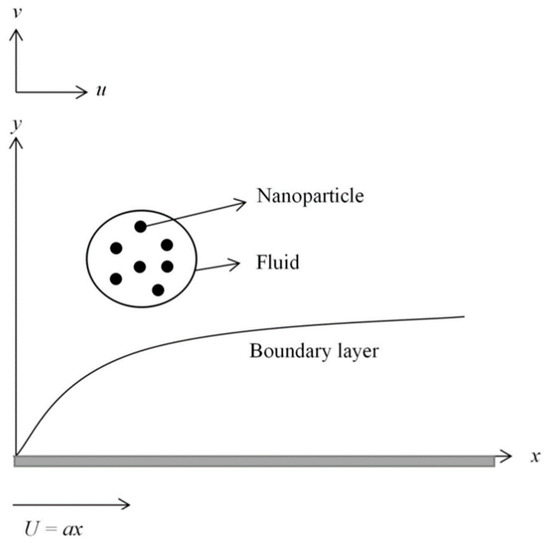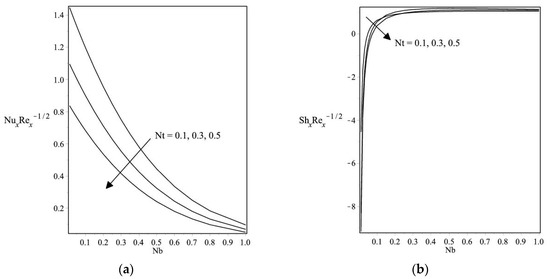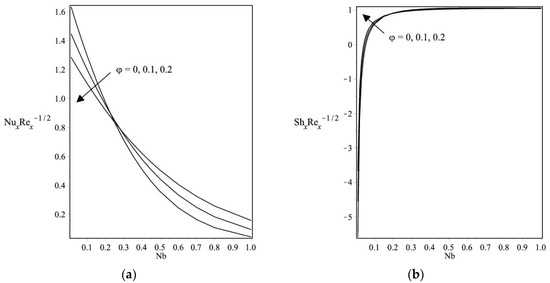Abstract
This paper reports the use of a numerical solution of nanofluid flow. The boundary layer flow over a stretching sheet in combination of two nanofluids models is studied. The partial differential equation that governs this model was transformed into a nonlinear ordinary differential equation by using similarity variables, and the numerical results were obtained by applying the shooting technique. Copper (Cu) nanoparticles (water-based fluid) were used in this study. This paper presents and discusses all numerical results, including those for the local Sherwood number and the local Nusselt number. Additionally, the effects of the nanoparticle volume fraction, Brownian motion Nb, and thermophoresis Nt on the performance of heat transfer are discussed. The results show that the stretching sheet has a unique solution: as the nanoparticle volume fraction φ (φ = 0), Nt (Nt = 0.1), and Nb decrease, the rate of heat transfer increases. Furthermore, as φ (φ = 0) and Nb decrease, the rate of mass transfer increases. The data of the Nusselt and Sherwood numbers were tested using different statistical distributions, and it is found that both datasets fit the Weibull distribution for different values of Nt and rotating φ.
1. Introduction
In recent years, many researchers have investigated stretching plates, which are used in industry for materials such as lubricants and glass fibers. The theory of flow over a stretching plate was first proposed by Crane [1]. Researchers [2] have also analyzed heat transfer over a stretching sheet with a permeable surface. Related studies involving a stretching surface were conducted by Grubka and Bobba [3], Ali [4], Wang [5], and Hayat et al. [6]. Convective heat transfer is a very important property of nanofluids, and the addition of nanoparticles has been found to improve the thermal conductivity. Widely used types of nanoparticles include monotubes, carbide nanoparticles, and metal nanoparticles, which can be added to base fluids such as glycol, ethylene, and engine oil. One of the important properties of nanofluids is their ability to enhance the thermal properties of fluids. Nanofluids have numerous applications, including electronics, biomedicine, nuclear reactors, and space technology. Khan [7], Choi [8], Masuda [9], Choi [10], and Wang [11] used nanoparticles to study the thermal conductivity. In the presence of nanoparticles, Wang [12] examined heat transfer and nanofluid flow by using a nanofluid model, which can also be used to study hydromagnetic flow over a permeable sheet [13]. Using a nanofluid model, Bachok [14] studied the effect of two elements in nanofluids, namely, Brownian motion and thermophoresis. These elements have been used to characterize the flow over a permeable surface [15] and an isothermal vertical plate [16]. Flow and heat transfer in turbulent flow were studied by Z. Taghizabeh-Tabari [17], and their results showed that the rate of heat transfer enhancement and pressure drop increment were greater for a plate heat exchanger (PHE) under turbulent flow conditions. Mahian [18] asserted that it is crucial to use measured data for thermophysical properties to predict the heat transfer coefficient with high accuracy. The analysis reported in [19] revealed that the effect of adding nanoparticles to the base fluid has a strong influence on the heat transfer enhancement by increasing the Reynolds number of flows and increasing the heat transfer. Heydari [20] used water as the base fluid and investigated the effect of the volume fraction of nanoparticles (TiO2) on the heat transfer and physical properties of the fluid. In a different approach, Hemmat [21] introduced and used a neural network as a powerful tool for estimating the thermophysical properties of nanofluids. The resulting empirical relationship could predict the thermal conductivity coefficient of water–EG–Al2O3 nanofluid with acceptable precision. Pourfattah [22] numerically investigated the rate of heat transfer enhancement for the flow regime inside a tube. The rotating flow in fluids has also been studied extensively in the past several years. The rotating flow over a stretching sheet is significant in several manufacturing processes, such as the extrusion of plastic sheets, glass blowing, fiber spinning, and continuous molding [23]. Usoicz [24] studied a physical–statistical model that provided highly accurate predictions of the thermal conductivity of nanofluids. Because nanofluids are essential in many applications, understanding their fundamental properties is crucial for exploring their use and potential benefits. Previous studies have demonstrated that the effective enhancement of the base fluid is important for improving its thermal efficiency [25]. Therefore, in this paper, building on previous studies [26,27], we propose combining the two nanofluid equation models developed by Buongiorno [15] and Tiwari and Das [12]. Our objective is to determine the effect of two key parameters: thermophoresis and Brownian motion. The shooting technique was used to obtain the results for the local Sherwood number and local Nusselt number. We present a physical–statistical model, as well as its distribution to predict the thermal conductivity of a fluid containing copper nanoparticles. The proposed model can be used for a wide range of practical applications in further studies on nanofluids.
2. Problem Formulation
We consider the three-dimensional free convection boundary layer flow for an area past a stretching sheet, with a stagnation point and conditions for the plane . We consider the flow to be incompressible, laminar, and steady. The flow is assumed to have a stretching velocity that varies linearly from , with and ( are constants, with ). The scheme of the physical configuration is depicted in Figure 1.

Figure 1.
Schematic diagram of the problem.
The same assumption also applies to the velocity of the fluid . The governing equations for a stretching sheet, where , are as follows.
subject to
where v is the velocity of the component in the y-direction, and u is the velocity of the component in the x-direction. Tw, T∞, and T are the surface temperature, ambient temperature, and temperature, respectively. C is the nanoparticle volume fraction, C∞ is the nanoparticle volume fraction far from the plate, and Cw is the nanoparticle volume fraction at the plate. DT is the coefficient of thermophoretic diffusion, and DB is the coefficient of Brownian diffusion. The ratio of heat capacity is τ = (ρCp)s/(ρCp)f, in which (ρCp)s represents the heat capacity of the nanoparticle, and (ρCp)f represents the heat capacity of the fluid. Further, αnf is the nanofluid thermal diffusivity, μnf is the nanofluid viscosity, and ρnf is the nanofluid density. These parameters were previously described by Oztop [28].
where the parameter φ is the nanoparticle volume fraction, (ρCp)nf is the heat capacity of the nanofluid, knf is the thermal conductivity of the nanofluid, kf is the thermal conductivity of the fluid, ks is the thermal conductivity of the solid, ρf is the fluid density, μf is the fluid viscosity, and ρs is the density of the solid. According to Abu-Nada [25], the term knf is used for spherical nanoparticles, and its value is negligible for other shapes. Next, given the constraints in Equation (5), the similarity solution of Equations (1)–(4) is computed; Equation (4) was proposed by Buongiorno [15]. We introduce the similarity transformations below.
where is a dimensionless variable for temperature, and is a dimensionless variable for nanoparticle concentration. The boundary conditions are
subject to the boundary conditions
The Brownian motion parameter is
the thermophoresis parameter is
the Prandtl number is
the Lewis number is
the stretching parameter is
the skin friction coefficient is
the local Nusselt number is
the local Sherwood number is
and the local Reynolds number is
The data for the Nusselt and Sherwood numbers were tested using the Akaike information criterion (AIC). This test is used to find the goodness of fit and determine the distribution that best fits the data. Table 1 lists the different statistical distributions. For each distribution in the table, the AIC was calculated, and the best distribution was identified from the AIC values.

Table 1.
The distribution test for Nusselt and Sherwood numbers.
The AIC measures the quality of statistical models for a sample set of data. The model that provides the lowest AIC value best fits the data. The formula for the AIC is
where L is a model of the likelihood function, and k is the number of parameters.
3. Results and Discussion
The shooting technique was used to determine the numerical solutions for Equations (9)–(11) with the boundary conditions in Equation (12). The shooting method converts a boundary value problem (BVP) into an initial value problem (IVP). The main reason for using the shooting method is that it can establish the applicable initial conditions for a related IVP to generate the solution to the BVP. This method was applied in the Maple programming language using the “dsolve” command and “shoot” implementation. The influences of Nb, Nt, and φ on the heat transfer rate were investigated for Cu nanoparticles. The values of the thermophysical properties are shown in Table 2.

Table 2.
Thermophysical properties of a nanofluid [18].
When φ = 0 for a regular fluid, the range of φ should be 0–0.2 [18]. The value of Pr (Prandtl number) is 6.2. Figure 2a,b depicts the variation in the local Nusselt number and Sherwood number with Nb for different Nt when φ = 0.1, Pr = 6.2, Le = 3, and ε = 1.2 for the stretching case. As clearly shown in Figure 2a, as Nb increases, the local Nusselt number decreases, while Figure 2b shows the opposite trend. Furthermore, Figure 3a,b shows that the local Nusselt number and local Sherwood number vary with Nb for different φ when Pr = 6.2, Nt = 0.1, Le = 3, and ε = 1.2 for the stretching case. These figures reveal that as Nb increases, the local Nusselt number and local Sherwood number decrease. It is important to note that the Brownian motion parameter Nb and thermophoresis Nt are related to the random motion of nanoparticles (Cu). For small values of Nb and Nt, the viscosity of the base fluid is weak, and the nanoparticles (Cu) tend to move easily among each other. Because of this phenomenon, the fluid is cooled faster, and the heat transfer rate increases.

Figure 2.
Variations in (a) the local Nusselt number and (b) the local Sherwood number with Nb for different Nt when Pr = 6.2, φ = 0.1 Le = 3, and ε = 1.2 for Cu.

Figure 3.
Variations in (a) the local Nusselt number and (b) the local Sherwood number with Nb for different φ when Pr = 6.2, ε = 1.2, Le = 3, and Nt = 0.1 for Cu.
On the basis of Figure 2 and Figure 3, the data for the Nusselt and Sherwood numbers were further analyzed to obtain the statistical properties for the tested distributions. Table 3 and Table 4 show the parameters for different distributions that were tested with the data.

Table 3.
Parameters of statistical distributions for the Nusselt number.

Table 4.
Parameters of statistical distributions for the Sherwood number.
Table 5 and Table 6 show the Akaike information criteria for the Nusselt and Sherwood numbers. The results show that the lowest AIC values are those for the Weibull distribution. It was also found that as the values of Nt and φ increase, the AIC values still indicate that the Weibull distribution is optimal.

Table 5.
Akaike information criteria (AIC) for the Nusselt number.

Table 6.
Akaike information criteria (AIC) for the Sherwood number.
4. Conclusions
Nanofluid flow past a stretching sheet and the influences of parameters Nb, Nt, and φ were examined and studied. From this investigation, a unique solution was obtained for the stretching sheet. It was found that as Nb and Nt decrease, the rate of heat transfer increases, but the rate of mass transfer decreases. The case is different when φ decreases: Nb decreases, and the rates of heat and mass transfer decrease. These results show that for different Nt and φ, the Weibull distribution best fits both the Nusselt and Sherwood data.
Author Contributions
A.J. in charge of writing the original draft and editing. A.S. supported on conceptualization. N.R. act as project administration. H.O. run software for analysis. N.A.Z. provided data curation. N.Z. do validation of results. N.A.A.B. in charge of review and editing. K.D.P., T.Y.T. are in charge of formal analysis. All authors have read and agreed to the published version of the manuscript.
Funding
This research was funded by Universiti Kebangsaan Malaysia, grant number GGPM-2017-036.
Acknowledgments
The authors warmly thank the reviewers for their time spent in reading the manuscript and for their valuable comments and suggestions.
Conflicts of Interest
The authors declare no conflict of interest.
References
- Crane, L.J. Flow past a stretching plate. Z. Angew. Math. Phys. 1970, 21, 645–647. [Google Scholar] [CrossRef]
- Gupta, P.S.; Gupta, A.S. Heat and mass transfer of a continuous stretching surface with suction or blowing. Can. J. Chem. Eng. 1977, 55, 74–76. [Google Scholar] [CrossRef]
- Grubka, L.G.; Bobba, K.M. Heat transfer characteristics of a continuous stretching surface with variable temperature. ASME J. Heat Transfer 1985, 107, 248–250. [Google Scholar] [CrossRef]
- Ali, M.E. Heat transfer characteristics of a continuous stretching surface. Warme Stoffubertragung 1994, 29, 227–234. [Google Scholar] [CrossRef]
- Wang, C.Y. Analysis of viscous flow due to a stretching sheet with surface slip and suction. Nonlinear Anal. Real World Appl. 2009, 10, 375–380. [Google Scholar] [CrossRef]
- Hayat, T.; Javed, T.; Abbas, Z. Slip flow and heat transfer of a second grade fluid past a stretching sheet through a porous space. Int. J. Heat Mass Transfer 2008, 51, 4528–4534. [Google Scholar] [CrossRef]
- Khan, W.A.; Pop, I. Boundary layer flow of a nanofluid past a stretching sheet. Int. J. Heat Mass Transfer 2010, 53, 2477–2483. [Google Scholar] [CrossRef]
- Choi, S.U.S. Enhancing thermal conductivity of fluid with nanoparticles. In Proceedings of the ASME International Mechanical Engineering Congress and Exposition, San Francisco, CA, USA, 12–17 November 1995; pp. 99–105. [Google Scholar]
- Masuda, H.; Ebata, A.; Teramae, K.; Hishinuma, N. Alteration of thermal conductivity and viscosity of liquid by dispers- ing ultra-fine particles. Netsu Bussei 1993, 7, 227–233. [Google Scholar] [CrossRef]
- Choi, S.U.S.; Zhang, Z.G.; Yu, W.; Lockwood, F.E.; Grulke, E.A. Anomalous thermal conductivity enhancement in nanotube suspensions. Appl. Phys. Lett. 2001, 79, 2252–2254. [Google Scholar] [CrossRef]
- Wang, X.-Q.; Mumjudar, A.S. Heat transfer characteristics of nanofluids: A review. Int. J. Therm. Sci. 2007, 46, 1–19. [Google Scholar] [CrossRef]
- Tiwari, R.K.; Das, M.K. Heat transfer augmentation in a two-sided lid-driven differentially heated square cavity utilizing nanofluids. Int. J. Heat Mass Transfer 2007, 50, 2002–2018. [Google Scholar] [CrossRef]
- Kameswaran, P.K.; Narayana, M.; Sibanda, P.; Murthy, P.V.S.N. Hydromagnetic nanofluid flow due to a stretching or shrinking sheet with viscous dissipation and chemical reaction effects. Int. J. Heat Mass Transfer 2012, 55, 7587–7595. [Google Scholar] [CrossRef]
- Bachok, N.; Ishak, A.; Pop, I. Stagnation-point flow over a stretching/shrinking sheet in a nanofluid. Nanoscale Res. Lett. 2011, 6, 623–633. [Google Scholar] [CrossRef] [PubMed]
- Boungiorno, J. Convective transport in nanofluids. ASME J. Heat Transfer 2006, 128, 240–250. [Google Scholar] [CrossRef]
- Bachok, N.; Ishak, A.; Pop, I. Boundary layer stagnation-point flow toward a stretching/shrinking sheet in a nanofluid. J. Heat Transfer 2013, 135, 054501. [Google Scholar] [CrossRef]
- Taghizadeh-Tabari, Z.; Heris, S.Z.; Moradi, M.; Kahani, M. The study on application of TiO2/water nanofluid in plate heat exchanger of milk pasteurization industries. Renew. Sustain. Energy Rev. 2016, 58, 1318–1326. [Google Scholar] [CrossRef]
- Mahian, O.; Kianifar, A.; Heris, S.Z.; Wongwises, S. Natural convection of silica nanofluids in square and triangular enclosures: Theoretical and experimental study. Int. J. Heat Mass Transfer 2016, 99, 792–804. [Google Scholar] [CrossRef]
- Rezaei, O.; Akbari, O.A.; Marzban, A.; Toghraie, D.; Pourfattah, F.; Mashayekhi, R. The numerical investigation of heat transfer and pressure drop of turbulent flow in a triangular microchannel. Phys. E Low-Dimens. Syst. Nanostruct. 2017, 93, 179–189. [Google Scholar] [CrossRef]
- Heydari, M.; Toghraie, D.; Akbari, O.A. The effect of semi-attached and offset mid-truncated ribs and Water/TiO2 nanofluid on flow and heat transfer properties in a triangular microchannel. Therm. Sci. Eng. Prog. 2017, 2, 140–150. [Google Scholar] [CrossRef]
- Hemmat, M.E.; Ahangar, M.R.H.; Toghraie, D.; Hajmohammad, M.H.; Rostamian, H.; Tourang, H. Designing artificial neural network on thermal conductivity of Al2O3–water–EG (60–40 %) nanofluid using experimental data. J. Therm. Anal. Calorim. 2016, 126, 837. [Google Scholar] [CrossRef]
- Pourfattah, F.; Motamedian, M.; Sheikhzadeh, G.; Toghraie, D.; Akbari, O.A. The numerical investigation of angle of attack of inclined rectangular rib on the turbulent heat transfer of Water-Al2O3 nanofluid in a tube. Int. J. Mech. Sci. 2017, 131–132, 1106–1116. [Google Scholar] [CrossRef]
- Bakar, N.A.A.; Bachok, N.; Arifin, N.M. Rotating Flow Over a Shrinking Sheet in Nanofluid Using Buongiorno Model and Thermophysical Properties of Nanoliquids. J. Nanofluids 2017, 6, 1–12. [Google Scholar] [CrossRef]
- Usowicz, B.; Usowicz, J.B.; Usowicz, L.B. Physical-Statistical Model of Thermal Conductivity of Nanofluids. J. Nanomater. 2014, 2014, 756765. [Google Scholar] [CrossRef]
- Abu-Nada, E. Application of nanofluids for heat transfer enhancement of separated flow encountered in a backward facing step. Int. J. Heat Fluid Flow 2008, 29, 242–249. [Google Scholar] [CrossRef]
- Nadeem, A.S.; Rehman, U.; Mehmood, R. Boundary Layer Flow of Rotating Two Phase Nanofluid Over a Stretching Surface. Heat Transfer.-Asian Res. 2016, 45, 285. [Google Scholar] [CrossRef]
- Rosali, H.; Ishak, A.; Nazar, R.; Pop, I. Rotating flow over an exponentially shrinking sheet with suction. J. Mol. Liquids 2015, 211, 965–969. [Google Scholar] [CrossRef]
- Oztop, H.F.; Abu-Nada, E. Numerical study of natural convection in partially heated rectangular enclosures filled with nanofluids. Int. J. Heat Fluid Flow 2008, 29, 1326–1336. [Google Scholar] [CrossRef]
© 2020 by the authors. Licensee MDPI, Basel, Switzerland. This article is an open access article distributed under the terms and conditions of the Creative Commons Attribution (CC BY) license (http://creativecommons.org/licenses/by/4.0/).